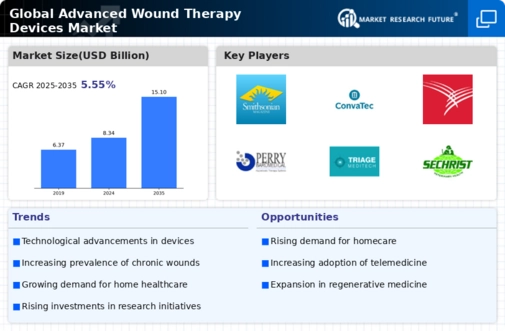Market Share
Advanced Wound Therapy Devices Market Share Analysis
The Advanced Wound Therapy Devices Market, crucial in providing innovative solutions for effective wound care, is highly competitive. Companies in this market employ diverse strategies to position themselves strategically and secure a significant market share. Constant product innovation is its first strategy. Corporations spend a lot of capital toward the research and development process; thus, supplying clinical improvements such as perceptive to consider sensors controlling arrangement strategies self- administered on recoveries and particularly for patient confinement. Innovation has also been a continuous feature in these companies which not only makes the companies unique from competitors but has also provided them an opportunity to have a great advantage on healthcare providers who want the best of solutions. However, recognizing the heterogeneity of wound types, companies acquire a desire to personalization guided by devices that are designed and manufactured for particular sorts of wounds. Providing specialized solutions has unique requirements for the healthcare professional, whether it is a basic chronic wound care and management or undergoing surgical treatments or suffering from traumatic injuries. Such strategy strengthens the marketplace position of the company ensuring that it attends to most clinical scenarios. Advanced Wound Therapy Devices Market endeavors at collaboration with healthcare institutions are imperative. Companies, therefore, establish partnerships with hospitals and other proficient organizations as well as wound care centers and research facilities to know more about the clinical requirements ensuring product validation through efficacy of their devices. Such collaborations not only contribute significantly to product development within the company but also increase its core position in the health care community, stimulating market share growth. Taking into account the worldwide spread of chronic wounds and anticipations connected in terms of demand for advanced wound care products, companies aim to increase global sales. This entails setting up distribution channels, making partnerships with local health organizations and implementing global standards to suit various regulatory frameworks. The companies have a chance to penetrate abroad and massify the market. Keen with pushing for the utilization of modern wound care devices, firms bring about educational campaigns. This entails training programs, workshops and even informational materials aimed at disseminating the necessary knowledge to healthcare professionals. Instructing physicians with regards to the advantages of these devices as well as how they should be used is also something that promotes product adoption apart from creating long lifelines and cultivating a greater market share. In the Advanced Wound Therapy Devices Market, creating a good base of evidence from clinical trials lays the need. For product branding and advertisement, companies fund the carrying out research studies such as clinical trials, case reports to prove the efficiency of their devices. With its contribution to making impression among and increasing the market share of healthcare professionals, scientific validation not only helps support product claims but also builds trust between end-users. In a product market that is channeled by value-based healthcare system, companies use strategic pricing as an integrated part of their business strategy to reflect the perceived price values of their advanced wound therapy devices. While these devices often come at a premium, demonstrating clear clinical and economic benefits justifies the pricing strategy. This approach attracts healthcare providers focused on delivering quality care and contributes to market share expansion.









Leave a Comment